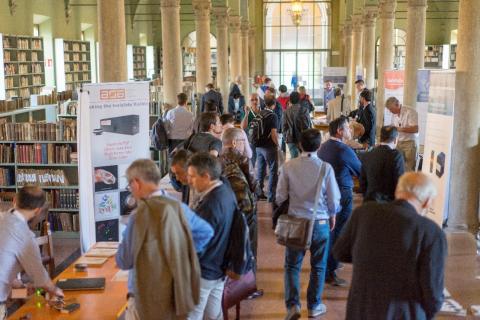2nd Academia Meets Industry Symposium

On 23 and 24 April 2018, the AIDA-2020 project hosted its second Academia Meets Industry (AMI) Symposium in Bologna, Italy.
The event was designed to promote interdisciplinary discussion and idea exchange amongst academic researchers and representatives from industry with experience or interest in the use of detectors and sources for non-destructive testing (NDT).
NDT is a minimally damaging technique that uses radiation sources and detectors for evaluating materials, components and systems to ensure all aspects of a system function correctly, reliably and cost-effectively.
NDT represented a market of 15 billion dollars in 2016 with a forecasted compound annual growth rate (CAGR) of 8 to 10%. The X-ray detection technologies used in NDT are similar to the technologies used in high-energy physics, which was very apparent in the presentations by the 14 industry and four academia speakers. Besides the speeches, the 87 participants (31 from industry and 56 from academia coming in total from 18 countries) had the possibility to meet in business-to-business (B2B) meetings and gather at twelve company booths. The whole “business ecosystem” was present with representatives from the whole value chain: designers, producers, integrators and end users.
From the examples provided by industry, it was evident that large groups such as FCA (FIAT Chrysler Automobile), Leonardo or Airbus have growing needs in NDT. As Nello Li Pira, Head of Physical Analysis Department at Centro Ricerche Fiat explained: “This is due to the more and more advanced materials being used and their integration in the final products that are increasingly complex and therefore are costly to test in a destructive manner.” What companies specialised in NDT can offer is more applications of advanced technologies to test equipment in an extremely precise though non-destructive way. And academia is well placed to develop breakthrough technologies that can find applications in industry for NDT.
This can be shared by Malvern PANalytical, who acquired Pixirad, a company offering an innovative, high-quality X-ray imaging sensor with intrinsic digital characteristics. Their technology is rooted in fundamental physics, having emerged through a spin-off of the Italian National Institute for Nuclear Physics. As Arjan Noordermeer, Product Marketing Manager, stated: “it is important for a company such as Malvern Panalytical to keep track of the developments of technologies by academia to remain at the spearhead of innovation. Symposia like the AMI,help us to continue this fruitful cooperation”.
The AMI also allowed companies specialised in NDT to benchmark their activities against each other. Thibault Maquet, Area Sales Manager of X-RIS, a SME specialised in digital radiology, recognised that: “events like this AMI symposium represent a good opportunity to close the loop by being informed on the latest developments in technology. We can then analyze how they can serve the needs of final users. This is also a good way to present our products and to gather feedbacks, enabling us to build confidence in our pragmatic approach: customers need user-friendly solutions. This is even more true when talking about digital X-ray."
A view echoed by Professor Richard C. Lanza from MIT: “I decided to attend this symposium to represent some novel academic work on x-ray sources which originated outside of the usual NDT community and also to show that joining forces across technological expertise in both academic and industry can leverage benefits for the end-user. In some cases what the end-user needs is a combination never thought before that can be more than the sum of its parts. Academics often search for the best technology in isolation, but the best technology alone might be sub-optimal compared to a combination of less performing but mutually reinforcing technologies.”
And incorporating the end-users in the development cycle can turn into a competitive advantage down the line. This is exactly why Tomas Hofbauer came to the symposium. He is the Sales Manager for Advacam s.r.o, a spin-off from the Medipix collaborations, bringing the next generation of radiation imaging detectors to the scientific and industrial market: “The next release of our product is in June and we wanted to get feedback from users at the AMI. Coming here allowed us to better understand the issues our industrial clients are facing and to see what our competitors are offering. In the end, we are not selling a detector but a solution that responds to our clients’ needs. The illustrative example of such an approach is the new robotic NDT system provided and exhibited at AMI by Radalytica s.r.o.”
The different corners of the venue were buzzing with parallel discussions as the symposium finished with speed-networking bilateral meetings.
Aurélie Pezous, Knowledge Transfer Officer at CERN, organised the symposium as part of the AIDA-2020 project and was “thrilled to see so many interactions between the different actors of the ecosystem to reach a more profound understanding of their respective needs.” In this vein, she proposed to the AIDA-2020 work package leaders to better identify the fit between their technological developments and the required applications in industry. This fit also known as value proposition should be designed so as to raise the interest from industrial players.
When Academia Meets Industry, everybody learns from each other irrespective of their affiliation!
- Log in to post comments
